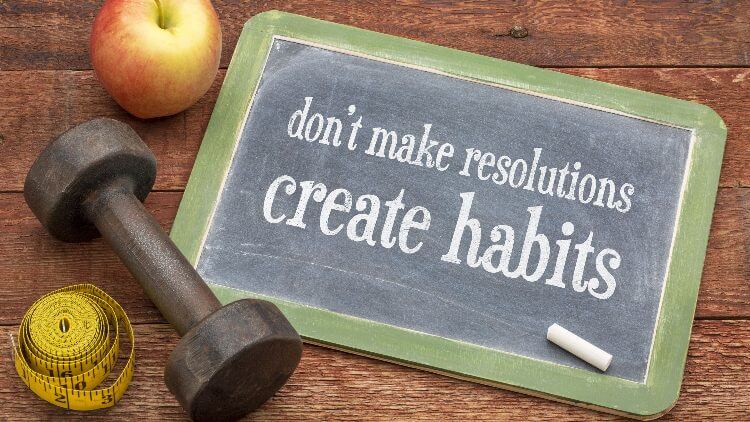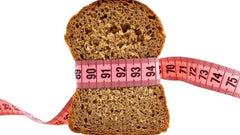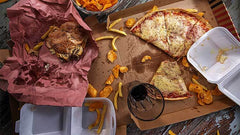
Why it’s So Important to Set Realistic Weight Loss Goals
It is only natural to want to lose weight fast, but is this kind of thinking realistic? All too often we get caught up by the pull of crash diets. With promises of speedy weight loss and beach ready bodies, we jump on board without thinking through the implications.
And this is a mistake. For lasting weight loss, you need to set realistic weight loss goals. More importantly, you need to accept that the key to losing weight is knowing that it will take time. Do that and your odds of keeping it off will be higher.
Don’t believe us? Let us show you why setting weight loss goals can make all the difference to your dieting ambitions.
- Why does it take so long to lose weight?
- Why it’s important to set realistic weight loss goals
- How to set weight loss goals
- Why losing weight is good for you?

Why does it take so long to lose weight?
We might live in a world filled with dieting strategies to suit every kind of lifestyle. However, when it comes down to it, the only realistic way to lose weight is to burn off more calories than you consume.
This means it doesn’t matter if you eliminate carbs or not. As long as you’re burning more calories that you are ingesting, then the pounds will drop off.
The Science
Our bodies require constant energy in order to function. Usually the source for this fuel comes from the carbs, fats and proteins we eat, as the calories they contain can either be converted into physical energy or be stored as body fat.
Now, unless you take steps to use up these stored calories, they will remain body fat, leading to eventual weight gain. That is why it is important to either reduce your calorie intake or increase your level of physical activity, to help minimize this storage.
In fact, get it right and you can ‘tip the scales’ – literally – and encourage your body to use more of these fat stores to fuel your body.
Sounds simple right?

Well, it is a little more complicated than that…
You see, 3,500 calories equals 1lb of fat. This means to lose just 1lb you must burn about 3,500 calories.
So how can you achieve this weight loss goal? Specialists recommend cutting 500-1,000 calories a day in order to achieve healthy weight loss goals of 1-2lbs per week.
Now, here is where things get a little more difficult, because when you lose weight, it is not simply fat. No, it is usually a combination of fat, lean tissue and water (especially during the first 2 weeks). Then there is the changes that occur in your body as a consequence of this weight loss.
For instance, as you lose weight you will need to adjust your calorie intake i.e. decrease it further, to ensure continued weight loss. Furthermore, then there are the following points to remember:
- Your dietary choices DO matter
For instance, our bodies find it easier to burn carbs than fat (as it is a quicker source of energy). So if you eat a lot of carbs your body will burn these carbs first.
Will this encourage weight loss? Yes, but the weight loss you’re looking for i.e. fat burn not carbs. For this reason, you will need to be conscious of where your calories are coming from to ensure you’re not eating too many carbs.
TIP: only consume 130g of carbs a day (45-65% of your daily intake).
-
Change carb and fat usage
You can change your carb and fat usage (in your body) depending on the speed, duration and intensity of your workouts.For instance, by choosing to do longer, low intensity runs; your body will gradually shift from using carbs to fats. This rule applies to other forms of exercise too. -
Do the right exercises
If your diet isn’t carb heavy, then you can focus on exercises that will help you to burn a larger quantity of calories e.g. running at 80-90% of your max. heart rate.This isn’t an all-out sprint, but is enough that you’re working out hard. In turn, you should integrate some interval and strength training into your workout to maximize your calorie burn.

Why it’s important to set realistic weight loss goals
You’ve probably read stories or spoken to friends who have succeeded in losing weight fast. But here is a question for you – despite this rapid weight loss, how many of them have succeeded in keeping this weight off? Very few of them, right?
And this is the danger…
You should NEVER try to lose weight too quickly, as this poses a number of risks to your body:
-
Muscle loss
Like we mentioned before, losing weight doesn’t always equal fat loss. When you lose weight fast, a lot of this weight loss is from muscle and water.During a study, when one group was given a low calorie intake of 500 calories a day for 5 weeks, and another group a diet of 1,250 calories a day for 12 weeks; not only did both groups lose a similar amount of weight, those on the 500 calorie diet lost 6 times more muscle than those on the 1,250 calorie diet. -
Slows down your metabolism
Your metabolism determines how many calories you burn every day, meaning should it slow down you will burn less calories.In fact, rapid weight loss from consuming fewer calories can cause you to burn 23% less calories a day. This is due to losses in muscle and falls in hormones which help to regulate your metabolism i.e. thyroid hormones.NOTE: even when you stop dieting, your metabolism may remain slow.
-
Nutritional deficiencies
This point explains itself, but here is a quick overview. A dramatically reduced calorie intake can make it difficult for you to get enough iron, folate and Vitamin B12.As a result, this lack of nutrients can lead to hair loss, extreme fatigue, poor immunity, and weak and brittle bones (lack of Vitamin D, calcium and phosphorus). -

-
Gallstones
This painful side effect of rapid weight loss crops up because your gallbladder’s job is to release digestive juices to help break down fatty acids (for digestion).When you eat less, these juices don’t get released, meaning the substances found in digestive juices will be forced to sit and eventually join together, forming gallstones. -
Other side effects
Fatigue, irritability, feeling cold, muscle cramps, dizziness, constipation or diarrhoea and dehydration.Now, this doesn’t mean you can’t safely reduce your calorie intake to support your weight loss. You just need to make sure that your diet is rich in whole, unprocessed foods.Not only do they contain less calories (per grams); whole foods can be quite filling, helping you to snack less and lose weight.
Then of course, you need to resist the temptation of setting weight loss goals that are too high…
According to a 2001 study by the University of Pennsylvania, they discovered that the average overweight person sets goals of losing 32% of their body weight. YET, this is three times too much. You only need to lose up to 10% of your body weight in order to improve your health.
But this isn’t the biggest concern…
When you set hefty weight loss goals of a third of your body weight – which is incredibly hard to achieve – this extreme goal is likely to set you up for disappointment and failure, and worse may result in you putting on more weight when you stop.
This is why realistic and achievable weight loss goals are so important.
-

How to set weight loss goals
Ask yourself this – what are realistic weight loss goals? What should you aim for?
Before you create any plan of action, you first need to know what smart weight loss goals are. Here are the facts:
-
You should aim to lose 1-2lbs (0.5-1kg) a week
This can be achieved by reducing your calorie intake by 500-1000 calories a day and exercising regularly. -
Depending on your weight, you should aim to lose a total of 5% of your body weight
This is realistic, achievable and can help to reduce your risk of heart disease and type 2 diabetes. - Knowing this, you’re now ready to create a plan.

-
-
Think about progress and outcome goals
A progress goal is deciding to walk for 30 minutes a day; whilst an outcome goal is deciding to lose 10lbs.Now, you don’t always have to set an outcome goal. However, creating a list of progress goals will increase your chances of hitting your long term goal of losing weight. More importantly, these progress goals will help you to change your habits i.e. physical activity. -
Set mini-goals
Mini-goals are great for keeping your motivation levels high as they are more attainable without a shorter time frame.For instance, setting a goal of dropping 4 dress sizes will take time, and whilst worth it (in the long run), can leave you feeling disheartened when you don’t do it fast enough. Yet, split this goal into smaller segments i.e. lose half a stone – that you can achieve within a month – and you’ll be more conscious of your achievements.PLUS, once you hit one mini goal, you can move onto your next one. TIP: track your progress and reward yourself when you hit a target e.g. going to the gym 5 times a week, as this will keep you feeling positive and motivated towards continuing with this healthier lifestyle.
-
Be mindful of what your goals entail
Losing half a stone sounds simple enough, but what if you want to drop a dress size? Clothing is difficult, as there isn’t a set amount you need to lose in order to a drop size.Then of course, there is the fact that clothing sizes can vary from company to company. Because of this, we suggest sticking to weight loss goals that you can actually measure, so you don’t lose heart.
-
Think about progress and outcome goals

-
Commitment
Truthfully? Healthy, sustainable weight loss takes time and effort. It is a long term commitment to permanent change that you must do for the right reasons.This means you must be certain that this is what you want. You’ve got to be focused – as it takes both mental and physical energy to change your ways. Because of this, before you make any commitment, you need to understand your triggers.You need to address the stresses in your life because even though you can’t always eliminate them (entirely); by recognizing and working to overcome them, you can ensure that they don’t sabotage your goals.
-
Make changes you can live with
Fact: you can lose weight on ANY diet. However, in order to experience real success, the changes you make have to be ones that you can live with.And that is the problem. We often adopt a diet, lose weight and then return to our old dietary habits.
Weight loss is NOT about dieting, but making long term lifestyle changes which cover both the foods you eat AND your physical activity.
That is why you need to review your bad habits and make gradual behavior/attitude changes that you can easily stick to for life. Examples:
-
- Remove the connection between watching TV and eating (this only encourages overeating and snacking).
- Eat slowly so your stomach has time to catch up and tell your brain it is full.
- Drink a glass of water before you eat a meal.
Fill up your spare time with activities to eliminate the temptation to snack.
- Set yourself a target of walking 5,000-10,000 steps a day (it is easier than you think).
As you can see, there are numerous ways you can make behavioral changes that – long term – can make a massive difference to your weight loss endeavors.
Be SMART
Specific, measurable, attainable, realistic and tangible. Apply this reasoning to all of your plans.
Ask yourself, do you need to lose weight
We often set goals based on what we think we should look like rather than what is best for our bodies. This means, many of us enter into a diet when we don’t need to.
That is why, before you set yourself any weight loss goals you first need to see if you fall into the following categories:
- Is your BMI higher than 25?
- Is your waist to hip ratio higher than .8 for women and 1 for men?
- Does your abdominal girth measure more than 35 inches (for women) and 40 inches (for men)?
- Do you get out of breath doing simple activities?
Even if you’ve answered ‘yes’ to these; don’t automatically think you need to lose weight. You should always speak to your doctor first.

Use a TDEE calculator
This calculator will help you to determine how many calories you should consume in order to achieve your weight loss goals.Not only does it take into account your height, gender, BMI and physical activity; it will also help you to calculate your calorie intake based on how much weight you want to lose and when by.
Using this information you can create a plan of action on how best to achieve these weight loss goals.
Weight loss doesn’t have to spell dramatic change
Truthfully, you may only need to make some modest changes to your lifestyle in order to achieve your weight loss goals.From reducing your carb and fat intake, to exercising more regularly, to opting for more whole foods (and not processed ones); these simple lifestyle changes can set you up for long term maintenance and success.
In fact, by starting off with small, healthy behavioral changes, you’ll begin to naturally do more as you’ll feel healthier, fitter and more energized.
Be prepared to reassess your strategies
Studies show that 3-6 months after you make behavioral changes, you’ll need to reassess your strategies.This may be due to your weight loss plateauing. Before you panic, this is completely natural.
Why? Because as you lose weight, you’ll gradually need less energy (as you aren’t as heavy). In this instance, you may need to increase your activity levels or adjust your diet to prompt further weight loss.
We won’t lie and say setting realistic weight loss goals is easy. Honestly? They will require some careful thought, consideration and planning – as well as some calculations.
HOWEVER, the results you’ll experience by being smart with your weight loss goals will ensure lasting, satisfying weight loss that you’ll easily be able to maintain, as you’ll have made healthier lifestyle changes.

Calculate your TDEE
Calculating your TDEE (Total Daily Energy Expenditure) is an important step to make – to ensure you set realistic weight loss goals – because this calculator is designed to calculate how many calories you burn each day.
And this is important, because the amount you burn is dependent on your current weight, gender, height and physical activity. This means that despite the generalization that women should have 2000 calories a day and men 2500 calories; we don’t all need this calorie amount. We are each unique…
Yet by adding this calculator to your weight loss plan – not only will it display your BMI, BMR, Macros etc.; you can also use it to calculate exactly how many calories you should have each day to ensure successful weight loss.
How it works
This calculator can work all of this out using either imperial or metric figures, and requires the following info: gender, age, weight, height and level of physical activity. It first calculates your BMR (the amount of calories you burn at rest) before multiplying it by an activity multiplier.Decide on your goal weight
Most experts will tell you to lose up to 5% of your bodyweight. However, before you jump onto that particular bandwagon, we recommend that you first take advantage of tools such as BMI calculators, as they’ll tell you what your ideal weight should be based on your age, height and sex.
True, it is not entirely accurate – as it can’t differentiate between fat mass and muscle mass. However, it can be used as an indication of much you should try to aim for.
Yet, if you do carry a lot of muscle (from working out or bodybuilding), then we suggest skipping this particular calculator and not basing your weight loss on your BMI. Instead, you should consider using a calorie and macro calculator (macronutrient calculator).
These are designed to help you gain muscle AND lose fat, by taking the following stats: age, gender, height, weight, goal (fat loss, maintenance or muscle gains) and level of activity. Using it, you can work out your individual macronutrient intake i.e. your protein, carb and fat intake (instead of your calorie intake).

Set the date for your goal weight
You could keep things simple and agree to lose 1-3lbs of fat per week, and that’s it. However, by setting an end date for reaching your desired weight; you can use this deadline to spur you on and keep you motivated.
Yet, this doesn’t mean you should set any old random date. This will only lead to an increased risk of failure if you give yourself too short of a deadline. Instead, harness a TDEE calculator to help you calculate an accurate calorie deficit that you can realistically stick to.
Take the following example: if you currently weigh 200lbs and want to get down to 180lbs. With a calorie deficit of 500 calories a day (500 calories off your TDEE), it would take you approx. 20 weeks to lose 20lbs of body fat (1lb per week).
Alternatively, if you want to lose 2lbs a week, you’ll need to create a calorie deficit of 1000 calories a day. Do that and you could reach this 20lb weight loss target in 10 weeks.
What you need to remember is that it will take time, and that it will be awhile before you spot any visual signs of weight loss (in your clothing and appearance). However, stay strong and stick to this weight loss approach, and you’ll find it easier to keep it off.
Don’t believe us? Take a look at these figures:
-
- 1kg of weight loss equals 7 apples
- 5kg of weight loss is the same as the weight of one cat
- 10kg of weight loss is the same as 67 bananas
- So even when you feel like you haven’t lost a lot. The truth is – you have lost more than you think…

Why losing weight is good for you?
Quite often our decision to lose weight is based on a need to improve our appearance and feel more confident in our bodies.
Yet this doesn’t have to be your only reason. In fact, there are a number of health perks to be had from reaching a healthy body weight. Even the smallest amount can make a real difference:
-
Lowered cholesterol
Less body fat can help lower cholesterol and risk of heart disease. -
Improved mood
5% reductions in body weight (within a 6 month period) can help you to feel and sleep better e.g. 8 hours of sleep can help to control hunger hormones and keep cravings at bay. -
Decreased inflammation
Chronic inflammation can occur from excess weight, leading to increased risks of heart disease, stroke and heart problems. In one study, losing 3 kilos helped decrease inflammation and boost immunity. -
Reduced joint pain
Research shows that reducing your body weight by 5 kilos can decrease your likelihood of developing osteoarthritis by over 50%. At the same time, you’ll be able to exercise for longer as there’ll be less pressure on your joints (equalling less joint pain). -
Lastly, just 1kg of weight loss can:
Help to lower stress; offer you clearer skin; boosts your immunity (less colds and ailments); improve your memory, and reduce allergies. -
Conclusion
So is it worth taking the time to set realistic weight loss goals? Yes it is!
Sure, the results you want won’t be immediate. And yeah you’ll need to be patient.
BUT long term these changes to your eating habits, behavior and attitude will mean that eating right and exercising regularly will feel 100% natural. And if it feels natural, you’ll find it easier to maintain.
In fact, you can easily incorporate weight loss supplements – such as proven fat burner PhenQ – into your diet and exercise plan, and watch as the pounds melt away.
So why not create a plan and see the difference? Achieving 1-2lb weekly weight losses is easier than you think…
The Real Reason It’s Harder To Lose Weight As You Get Older (And How To Break Through The Barrier)>>













